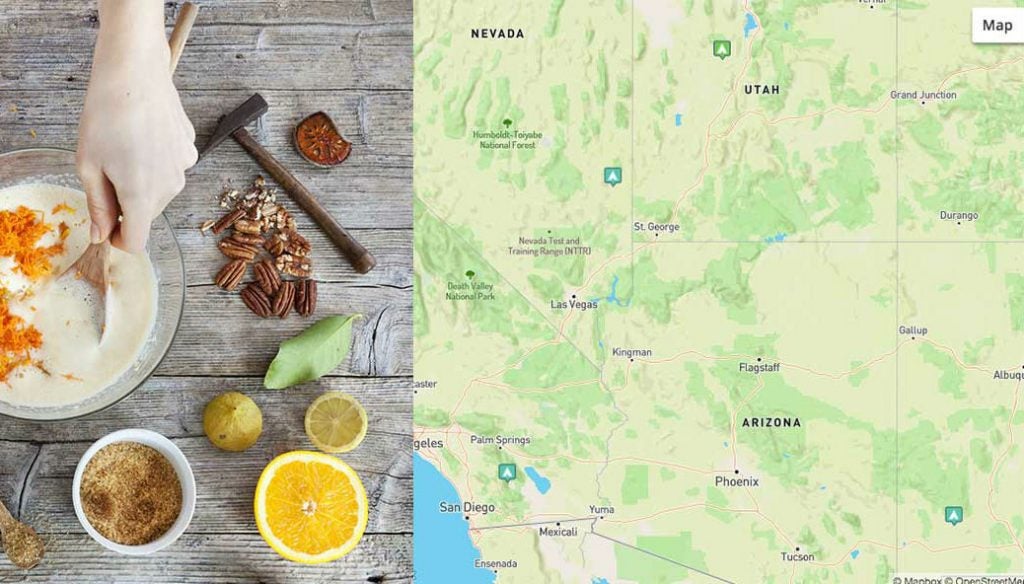This thru hiking article is brought to you by our friends at Brunton, architect of the simple yet tough navigational compass—perfect for thru hikes, or any adventure in the backcountry.
There are three major long-distance thru hikes in the United States: the Pacific Crest Trail, The Appalachian Trail, and the Continental Divide Trail. Completing all three hikes, or “The Big Three” earns you the Triple Crown. It’s a grueling physical feat, and an enormous time commitment. So what motivates someone to leave their old life behind for months at a time to hike day after day after day… after day?
The Dyrt caught up with Corey McPherson, a Triple Crown hiker and Bozeman, Montana resident, to learn more about what it’s really like to complete the entire 7,931 miles and 1,000,000 feet of vertical gain on all three of these epic thru hiking trails.
McPherson, whose trail name is Baggins, speaks of challenges, beauty, and a tale of ordering pizza from the CDT.
The Triple Crown: Thru Hiking the “Big Three”
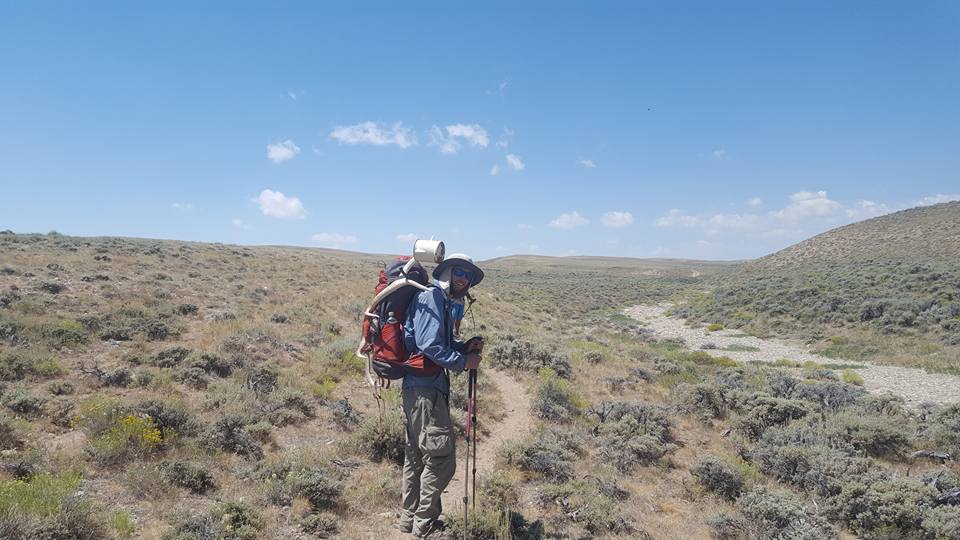
Great Divide Basin of the CDT
The Dyrt: What does it mean to be a Triple Crown long distance hiker?
Corey McPherson: To me, being a Triple Crowner is more of a personal achievement and is definitely something I enjoy looking back on. It just means that I was lucky enough to stay healthy and positive, and not have to get off trail. You have to be able to crawl out of your bag, pack up your stuff, and keep walking, even when it’s the last thing you want to do.
What was the order that you did these three hikes?
I completed “The Big Three” in a pretty traditional fashion. I started in March at Springer Mountain in Georgia and headed north for the Appalachian Trail. A year and a half later, I started in April in Campo, California and headed NoBo (northbound) again for the PCT. Then another year and a half later I started at the Crazy Cook Monument in New Mexico and headed north again for the CDT.
How many years did it take you to finish thru hiking all three? How many months did it take you to hike each one?
I started the AT in March of 2012 and completed the CDT in September of 2016.
Surprisingly, all the trails took about the exact same time, even though they are all significantly different in length. It was about five and a half months to complete each trail. This is mostly because on the AT, the miles come tough and 15-20 miles is considered a pretty good day. On the PCT and CDT you have longer, flatter stretches where 25-30 miles is sort of the norm—even pushing 40-50 miles in a day is not extremely uncommon in some areas.
“It wasn’t until later that I realized the hikers we passed started in Georgia and were trying to get to Maine by foot, on one trail. My mind was blown, and the seed had been planted.”

Those who consider themselves “Triple Crowners” on the CDT
What made you decide to try and hike all three of the major thru-hikes in the U.S.?
I had never even heard of the Appalachian Trail. It wasn’t until me and a buddy wanted to go on an overnight backpacking trip and started looking up trails in the area. We found this one trail called the Appalachian Trail, and just thought it was a local trail.
So we set out for a 50-mile stretch—trying to finish in about 4-5 days. Not too long into our hike, we started passing NoBo thru-hikers that started talking about places like Katahdin and Springer Mountain. I had no idea where these places were or what it meant.
It was about halfway through the trip when my buddy started giving into the steep ups and downs of the AT, and we realized we would not make it 50 miles. Luckily, we got to the interstate where the trail crossed and called someone to come pick us up. It wasn’t until later that I realized the hikers we passed started in Georgia and were trying to get to Maine by foot, on one trail.
My mind was blown and the seed had been planted. I was infected with the thought of walking from Georgia to Maine.

Midway point on the PCT
After completing the AT I told myself that would be it. About a year went by, and the thirst for adventure crept back into my soul, and it didn’t take much for me to be all-in on the PCT in 2014. While thru hiking the PCT, I knew that if I was lucky enough to finish, I would not leave the mystique and majesty of the CDT out on the table.
Immediately after finishing the PCT I told myself that in a year and a half I would be at the Mexican border to see what the CDT was all about.
I never really planned to hike the Triple Crown. It kind of went one… then why not two… then, “Well, I’ve done two and arguably the best one is left.”
Did you hike any of the three trails solo? If so, did you prefer thru hiking with people or without?
I started the AT solo, but you have to really try hard if you want to stay solo. I met up with another hiker, Pancake, in the first few hundred miles and we hiked most of the trail together. Same on the PCT. I started out solo, but within the first couple of days you start to see the same people over and over again. The trails are continuous moving bubbles of people. As you catch up to some bubbles, other bubbles are catching up to you, so you are constantly meeting new people.
The CDT is a different beast. I started with one other person who I didn’t know, and he was gone the first night. Hiking the first 90 miles in the desert solo was the only option.
It wasn’t until about 400 miles in, until I reached Pie Town, New Mexico where I met up with my buddy Scorpion, who I had hiked most of the PCT with. We stuck together for most of the trail, separating from time to time, but meeting back up along the way.
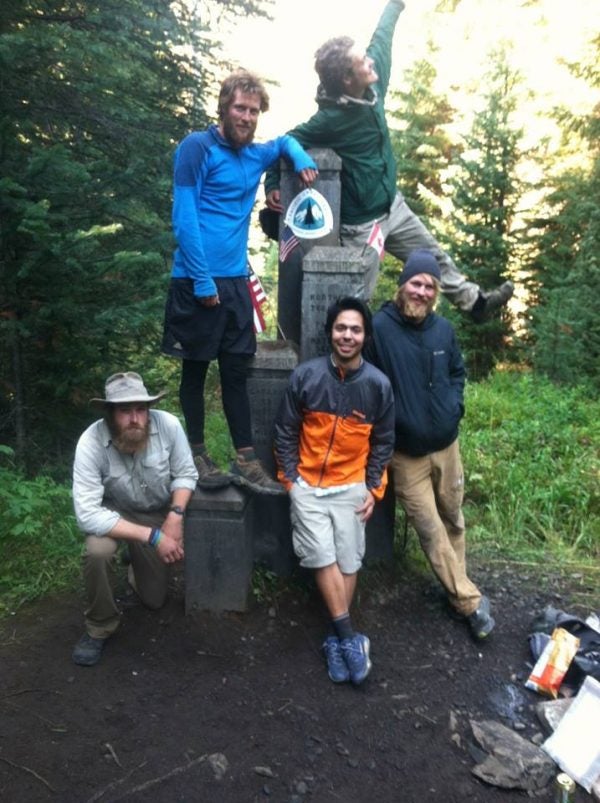
The finish at the Canadian border of the PCT
Sometimes it is important to make sure you are doing things that you want to do and not following the pack just to stay together. That’s where the saying “Hike Your Own Hike” comes in; you don’t want to get caught up in hiking other people’s hikes. You just have to go your own way and do your own thing.
Which thru-hike was your favorite and why?
This is a tough one, each experience was unique. The AT was sort of like a first love; it will always have a place in my heart. There is just something unique and special about the Appalachians with all of the history that took place in those mountains.
The Continental Divide Trail is extreme in every sense; extreme heat, extreme cold, extreme weather, extreme elevation, extreme exposure. The saying “Embrace the Brutality” is not understated. It can chew you up and spit you out if you are not prepared for it. But with extreme difficulty comes extreme rewards on the CDT.
I would say I had the best experience on the PCT. The scenery was amazing, the trail was fairly mellow, and the people I got to hike with on the PCT really separated it from the others.

The Wind River Range of Wyoming along the CDT
Out of your three hikes, what was the most challenging thru hiking experience on the trail?
The Mohoosik Notch in Maine—after torrential down pours all night turned the boulder filled ravine into a flowing stream—the one mile stretch of trail took about an hour and a half. Also a stretch on the CDT when I was hiking solo and had my phone and external battery die at the same time. I had to navigate about 70 miles of cross country travel, with hardly any trail markings and with map and compass.
Word of advice: No matter how easy a section of trail is, always carry a map of the area and a compass, and know how to use them—don’t always count on your electronics working.
What was the craziest experience you had while thru hiking?
An impromptu 50-mile day right before The Great Divide Basin. My buddy Cheetah and I made a push to get to Rawlins, Wyoming and ended up doing about 50 miles and were about 6 miles short of town. When we realized we had cell phone service we decided to try and order a pizza from the dirt road. So we called Papa Johns and they hooked it up—brought us a large extreme supreme pizza, with free bread sticks and soda.
What was the most awe-inspiring moment on the trail?
That’s a tough one. There was one time in the North Cascades where we were watching a black bear rummage through blueberry bushes as there was a golden eagle circling above our heads.
Another inspiring moment was cowboy camping on the ridge in Goat Rocks Wilderness. I woke up in the middle of the night and saw The Northern Lights going off behind Mt. Rainier.
There are lots of little things that happen along the way, too — these might not count as awe-inspiring, but inspire you nonetheless. For example, people genuinely helping people, for no other reason other than to help someone else. You see that a lot.
How would you rank the trails from easiest to hardest? Why?
You have to combine the mental difficulty vs. the physical difficulty. With its fairly mellow grades for most of the hike, consistent trail markings, and pretty consistent weather, I think the PCT was the easiest. There are a few long resupply stretches, but they are still doable.
The next on the difficulty scale would be the AT. With its steep and constant up then down route, and very fewer switchbacks, the AT is not to be taken lightly. Also, the weather seemed to be much more of a factor and I definitely had more thunderstorms than on any of the other trails. The shelter system and short resupply distances are what really make the AT a little easier.
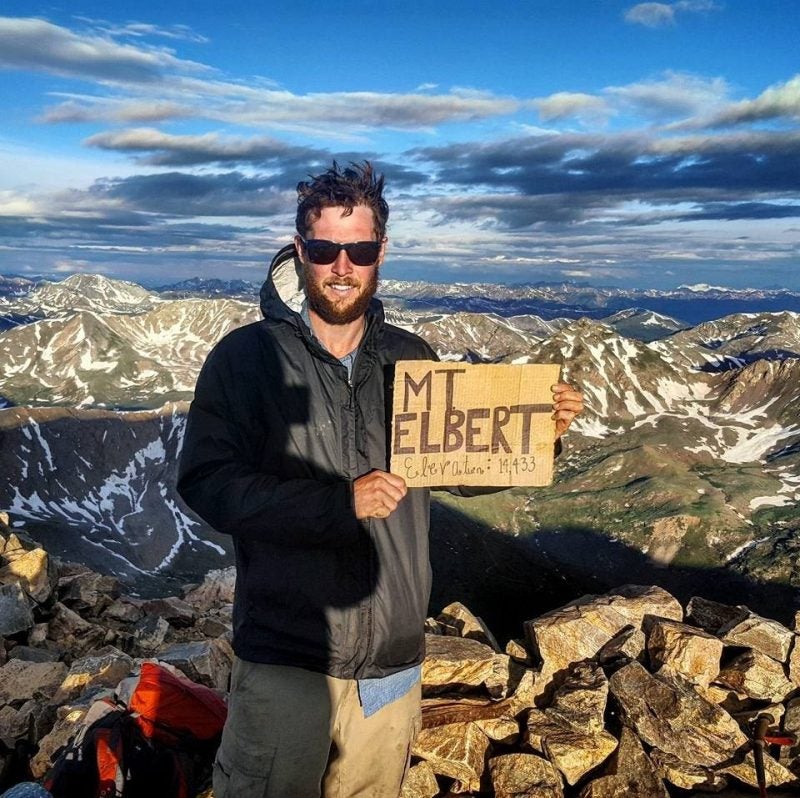
Mount Elbert, a 14er in Colorado along the CDT
The Continental Divide takes the cake in difficulty. With its long resupply stretches, and long waterless stretches, the CDT is also, by far, the least marked of the trails. Not to mention the CDT, especially through most of Colorado, is pretty much all above 9,000 feet, with some stretches staying well above 10,000 feet.
How did you stay motivated to hike when you were feeling down?
You just gotta put yourself in the moment. Think about what made you decide to do this in the first place.
I remember a few times thinking, What the hell am I doing this for, or, Guess I’ll just walk all day again today. The monotony can take hold if you allow it, but you just have to realize that this was something that you were so excited for. You finish the ascent you’re on, get an amazing view, then everything sort of makes sense again.
What was your most essential piece of thru hiking gear and why?
Just about every piece of gear you are carrying should be somewhat essential or you probably shouldn’t be carrying it. Your pack, shelter, and sleeping bag are the three most essential gear items.
Your footwear can make or break your hike pretty early on, if you have shoes that don’t fit properly. Water filters are a must-have for most people. Having a map and compass of the area is also crucial. I was usually known to have a little bit of sipping whiskey in my pack as well.
How much does a major thru-hike cost?
I have heard you typically spend about a dollar a mile. This is probably a safe number, but it can vary greatly from hiker to hiker. If you can start the trip and finish the trip without having to revamp your gear list, then that is a way to save some money.
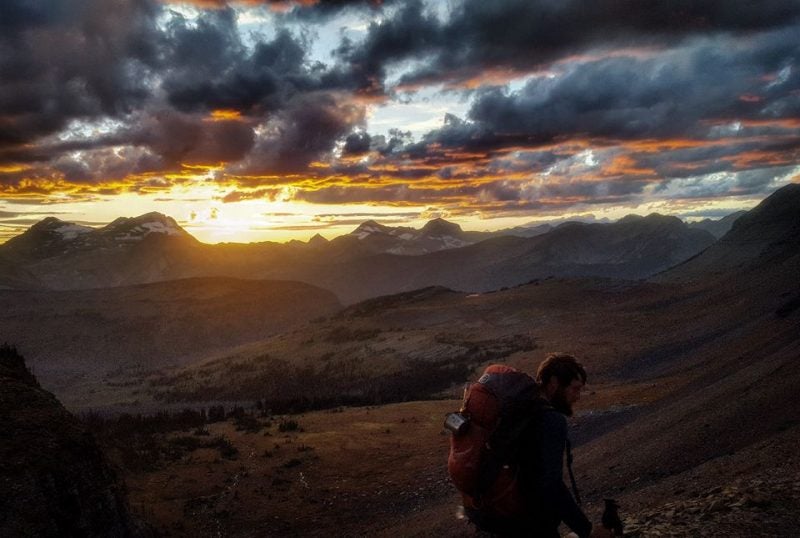
Last night on the CDT
How did you feel after you finished your third thru-hike?
It was the definition of bittersweet. On one hand you’re thrilled to have completed something that was in the making for five years and literally put your blood and sweat into.
On the other hand, you have this feeling of, what now? What do I do now that I’m 30 and don’t have a job? So the outside world doesn’t let you enjoy it for too long, before its right back to a dose of “reality.”
Do you have any other major thru hiking or outdoor goals? If so, what?
Nothing major. I make sure I’m getting out when I can and enjoying time outdoors. Whether that’s a day hike, two-day hike, or ten-day hike. It doesn’t always have to be a major goal to have a great time. There are lots of mountains in the west that would be awesome to hike, like Granite Peak in Montana and Grand Teton in Wyoming. I’m pretty sure a long thru-hike that is 2,000 miles won’t happen again — but never say never.
Biggest lessons learned while thru hiking?
While on the trail, there are no wrong decisions. Trust me, don’t get caught up on whether taking an alternate route is a good idea or not. The trail always has a way of working itself out, and you usually end up having made the right decision. Somehow even the “wrong” decisions end up being the best thing.
Understand that being able to attempt a thru-hike is a privilege and not something that should come with expectations. Just because you are thru hiking doesn’t give you any special permissions or special treatment. People are always willing to go out of their way and do whatever they can to try to help, but this shouldn’t become expected. If someone helps you along the way, lets you into their house, lets you shower, or feeds you, make sure you let them know how much you appreciate it.
Hike your own hike! If you want to do something on your trip, do it.
This interview has been edited for clarity. All photos were provided by Corey McPherson. Follow Corey on Instagram.



